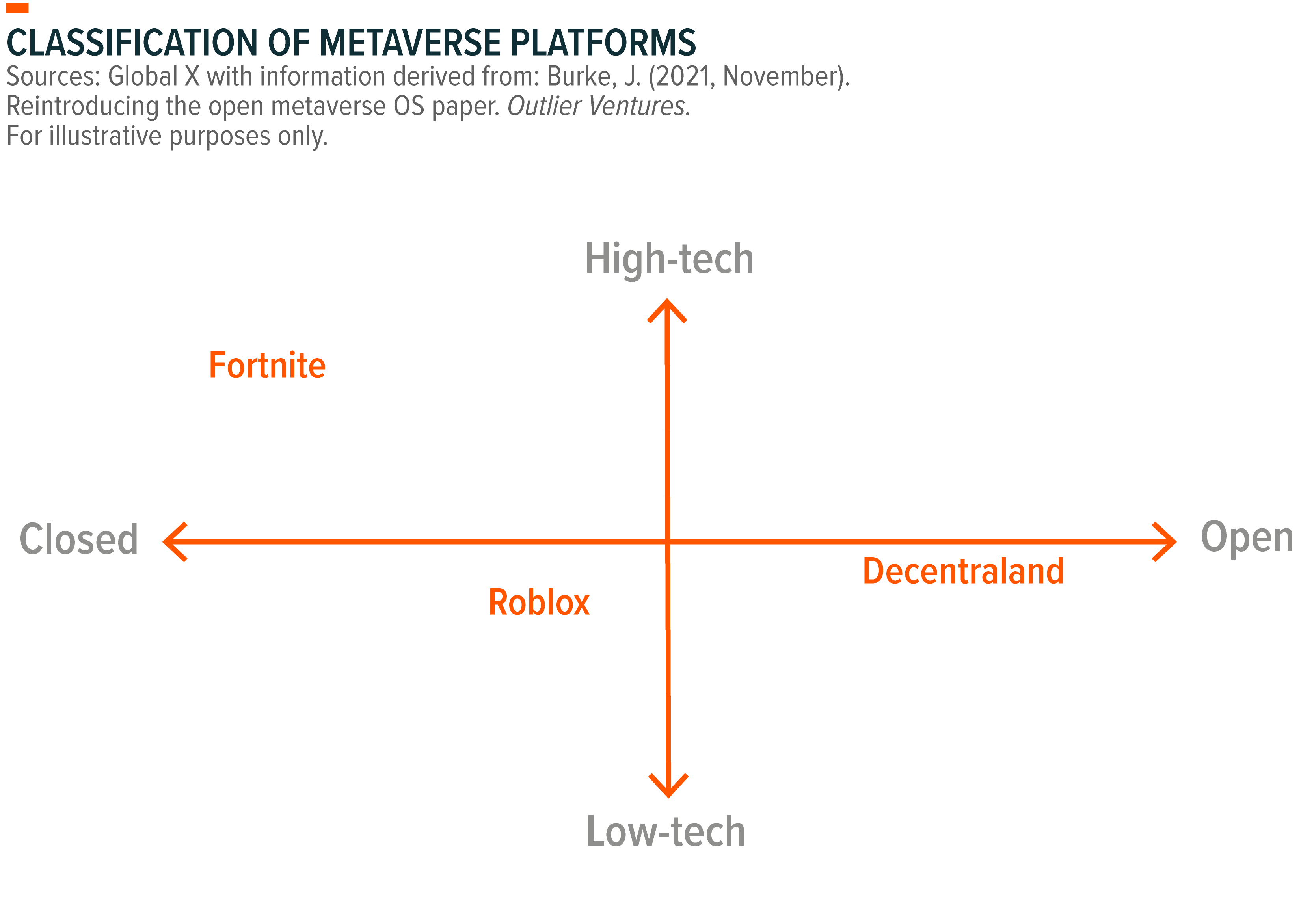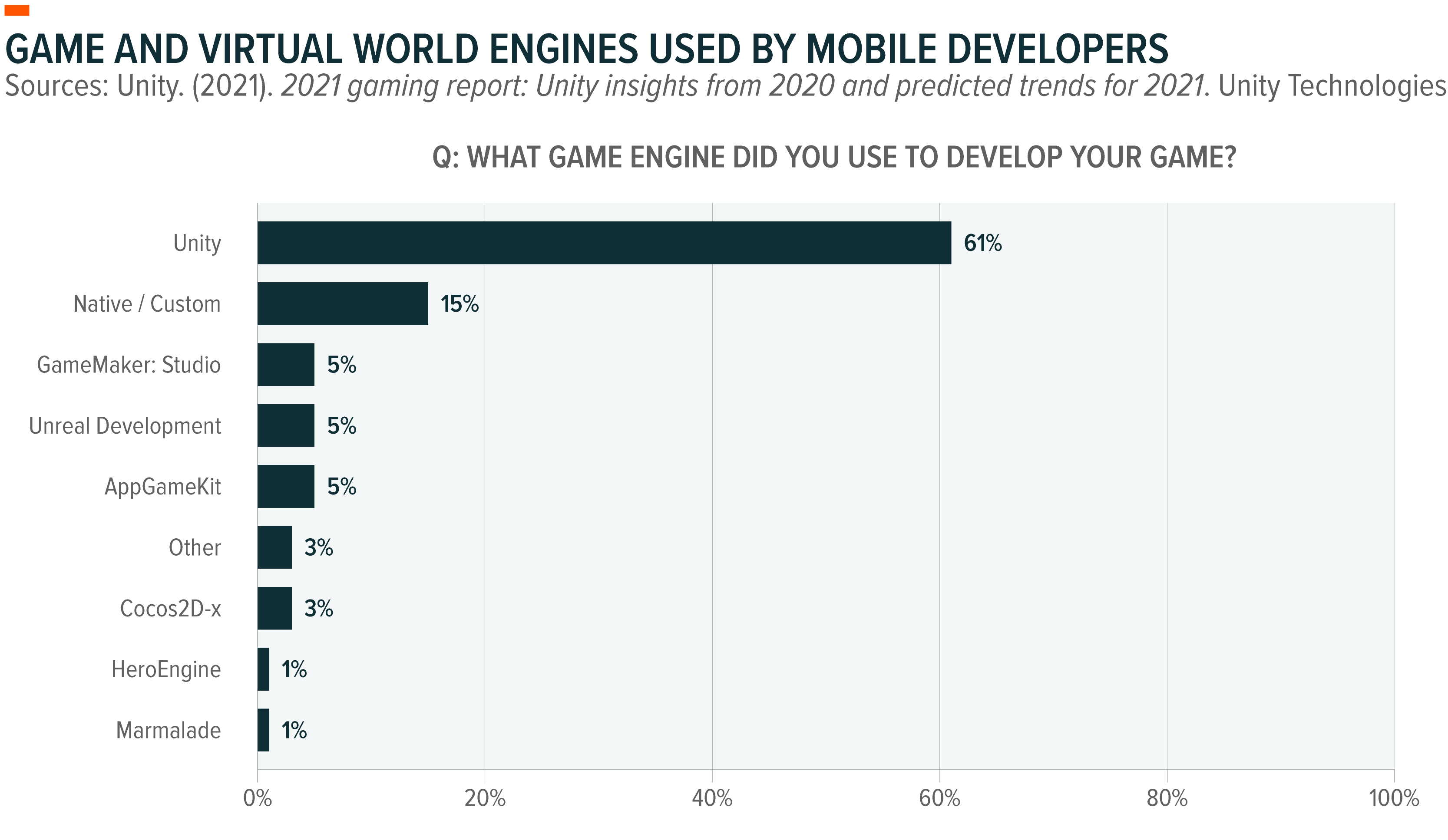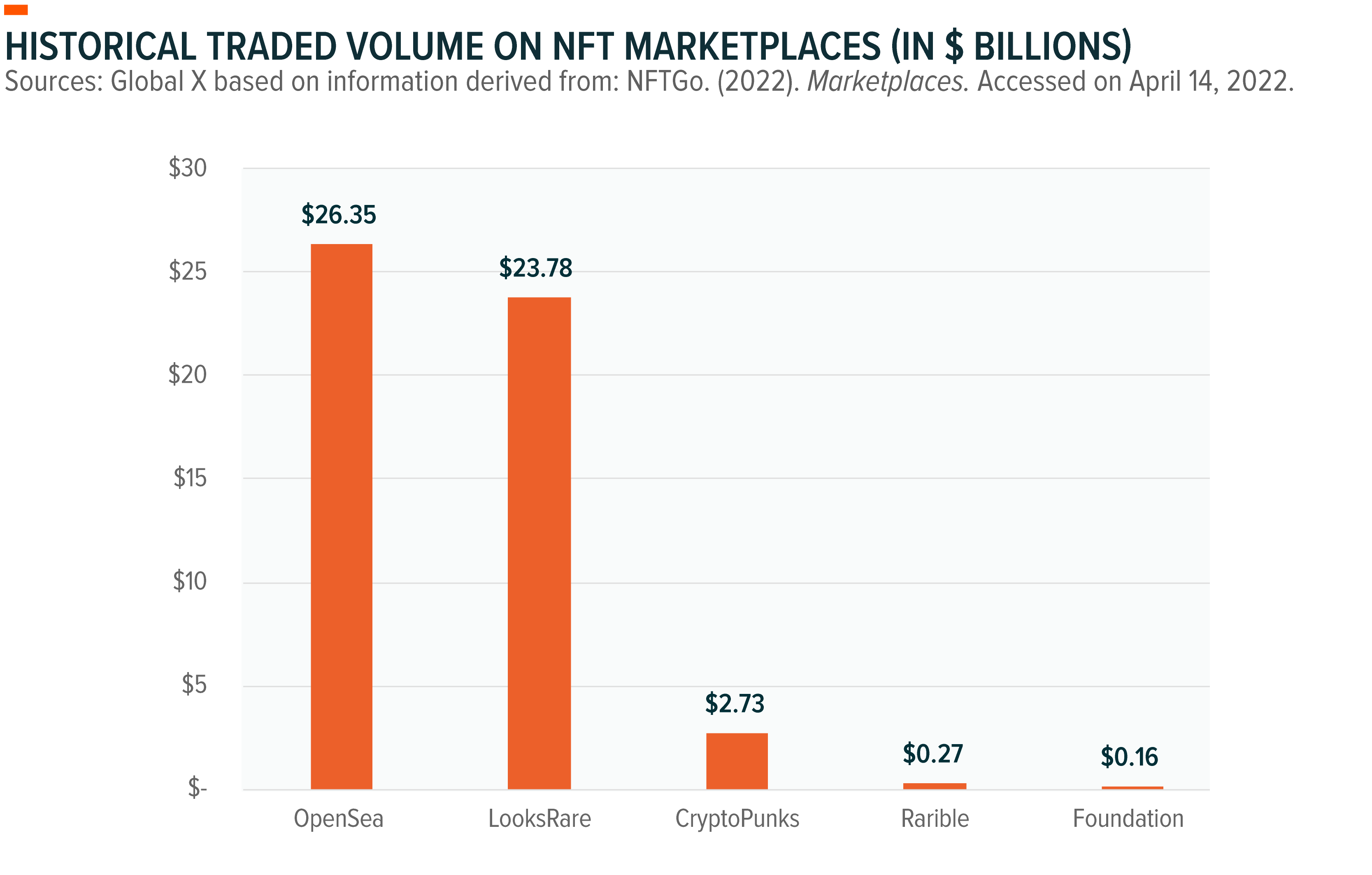Introducing VR: The Case for the Metaverse
On April 28th, 2022, we listed the Global X Metaverse ETF (VR) on Nasdaq. VR is designed to provide exposure to companies that are positioned to benefit from the development and commercialization of the metaverse. The metaverse is a set of virtual, three dimensional (3D), real-time rendered spaces and simulations that can be experienced simultaneously by users regardless of the users’ physical location.
On Meta Platform’s Q4 2021 earnings call, CEO Mark Zuckerberg and others mentioned the metaverse 11 different times.1 Microsoft mentioned the metaverse seven times on its call and Nvidia did so five times.2 But they’re not the only ones. In the last six months, companies around the world have mentioned the word “metaverse” more than 240 times during their earnings calls.3 Why are so many companies enamored with this term? It’s because many expect the metaverse to emerge as the next evolution of the internet, presenting today’s leading platforms and tech giants a trillion-dollar opportunity.4
But what is the metaverse? Why is it the likely successor to today’s internet? And which segments are best positioned to benefit from this evolution? In this piece, we explore these questions and more as we discuss how the metaverse could reshape the future of how we experience the digital world.
Key Takeaways
- The metaverse represents an internet in which users are immersed and virtually present. The metaverse consists of several key features including real-time persistency, economies, communities, digital avatars, and accessibility across multiple devices.
- Early versions of the metaverse exist already with short track records of success, offering investors a glimpse of its enormous potential. In time, we expect the most successful metaverses to feature decentralized, open architecture platforms powered by blockchain technology.
- With continued development, we believe the metaverse can create revenue opportunities for companies across multiple verticals, particularly for those companies involved in building virtual reality (VR), augmented reality (AR), as well as mixed reality (MR) hardware and software.
Defining the Metaverse
In today’s internet, digital platforms typically help facilitate physical-world experiences. We buy goods on Amazon that are shipped to our home, we share pictures on Instagram of our latest dinner out, and we buy tickets online to a concert at Madison Square Garden that we attend with friends.
In the metaverse, digital platforms facilitate largely digital-world experiences. By jumping into an immersive experience using a VR headset, we will be able to work, play video games, buy digital items, socialize with friends, and consume media. The metaverse is not a technology per se, but a vision of a new way of engaging with our world. Succinctly, Meta Platforms’ Zuckerberg describes the metaverse as a virtual environment where you can be present with other people in digital spaces.5
Broadly, we identify six main characteristics that define a metaverse:
- Identity:While digitally present in the metaverse, users can express themselves as whoever or whatever they want to be with their own avatar. To quote the science-fiction film Ready Player One, which depicts an infinite metaverse called the Oasis: “People come to the Oasis for all the things they can do, but they stay for all the things they can be: tall, beautiful, scary, a different sex, a different species, live action, cartoon, it’s all your call.”6
- Multi-device:The ability to access the metaverse from anywhere is a key feature, whether it’s your phone, PC, tablet, or other devices. One of the biggest leaps forward will likely be the immersive VR experience, which uses a head-mounted display to engulf users in a computer-generated environment where they can manipulate virtual objects. Lighter versions of the metaverse will also exist via traditional screens and devices.
- Immersive:A truly immersive experience engages all of a person’s senses: sight, hearing, touch, smell, and taste. Today, VR mostly involves surround sound and images. The next generation of VR devices could include haptic body suits and omnidirectional treadmills that give users physical sensations through electro-stimulation as they navigate a digital environment.
- Economy:A fully developed metaverse has a functioning economy where users can earn and spend in digital or fiat currencies. An early example of a metaverse with an online economy is the gaming platform Roblox and its currency, the Robux. Users who purchase Robux can spend it on experiences and items for their avatar. Developers and creators can earn Robux by building engaging experiences and compelling items that users want to purchase and converting those Robux back into fiat currencies, such as the U.S. dollar.
- Community:Users are not alone in the metaverse. They interact and share experiences with others. In looking at video games as an early form of the metaverse, enabling social experiences seems to be a core trait of successful titles. Activision Blizzard CEO Rob Kotick mentioned that players who play in groups with friends spend over three times more hours in the game and invest roughly three times more on in-game content compared to other players.7
- Real-time persistent:The metaverse is expected to be real-time persistent, with no ability to pause the experience, meaning that it will continue to exist and function even after users leave. Unlike other digital experiences, this trait puts the focus on the continued development of the virtual world itself rather than the user.
Early Days of the Metaverse Show Its Potential
The metaverse is not some futuristic idea; early versions already exist. Epic Games’ Fortnite has hosted virtual concerts with Ariana Grande and Travis Scott, where users attended as their digital avatars. The success of events like these has been staggering, drawing millions of fans and far outnumbering in-person shows.

In August 2021, Meta Platforms took a major step towards a metaverse when it unveiled “Horizon Workrooms,” a virtual meeting space where co-workers can interact with each other in the form of their digital avatars.8 Entering the workroom requires an Oculus VR headset and downloading the free app. These examples offer small glimpses of what a full metaverse could ultimately look like.
As companies invest further in building metaverse-related initiatives, it’s important to remember that what we call “the metaverse” isn’t necessarily a centralized monopoly. Metaverse development may yield more centralized and distinct experiences currently, but it’s working towards an end-state that is fully decentralized. And unlike in Ready Player One, which depicts a metaverse where the real world is left behind for one infinite virtual world, in our world, several metaverses are likely to emerge.
The Metaverse of the Future Expected to Move From Closed to Open Architecture
Today, companies offer their metaverse experiences primarily through closed architecture systems, which means that their software and/or hardware is not compatible with other platforms. Different platforms are often designed for different primary use cases, such as gaming, working, shopping, or socializing. Eventually, we expect the most successful metaverse platforms to evolve toward a more open architecture that allows many, if not all, users, developers, and companies to participate on equal terms.
An example of a truly open metaverse would be a decentralized virtual reality platform powered by blockchain technology. Such a concept already exists with Decentraland, Somnium Space, Sandbox, and others, which are built on the Ethereum blockchain. Unlike other virtual worlds and social networks, no single agent has the power to modify the rules of these virtual worlds’ software, land, or the economics of its currency. Community members can create, experience, and monetize content and applications. In some instances, community members can buy, develop, and sell land, which, like in the real world, is finite, making it more valuable.

When inside the most popular metaverse platforms, we expect users to find functioning economies where they can spend or earn currency. Many will view the metaverse as a space for entertainment and leisure, using the digital space to meet with friends, shop, and/or consume media. These types of platforms will likely benefit from network effects: the more users start to participate in the metaverse, the richer the digital experiences become, and the more these users start to attract their family, friends, and acquaintances to the platforms. But the metaverse isn’t all play. For developers and creators initially, and others eventually, the metaverse will be their place of work, where they participate in the business of these virtual worlds.
For users to participate, they will simply need an entry point, whether it’s a VR set, smartphone, or computer, and an internet connection. But the next generation of hardware could include haptic body suits, omnidirectional treadmills, and brain sensing wearables, making the virtual world even more realistic.
- Haptic body suits:Whether full body, vest-only, or gloves, these wearables provide users with a sense of touch in VR and AR settings through electro-stimulations or vibration motors. As users delve into experiences, the suits mimic sensations, such as a hug or raindrops.
- Omnidirectional treadmills:The ability to walk, run, and jump in any direction will allow users to bring physicality to their VR experiences. Today, best-in-class omnidirectional treadmills only feature the ability to walk. However, we expect future technologies to create more immersive experiences.
- Brain-sensing devices:Users could eventually control a virtual environment in real time through devices that analyze, interpret, and translate their own neural signals into digital commands. In some leading devices, machine learning algorithms decode brain activity and recognize the active visual focus, allowing the object in focus to move in the virtual world.
The Metaverse Could Be a Trillion-Dollar Opportunity
Evidence suggests that the metaverse could create wide-ranging revenue opportunities across multiple verticals, particularly for those companies involved in building virtual reality, augmented reality, and mixed reality hardware and software, semiconductors, as well as creator platforms and economies. The opportunity could potentially exceed $1 trillion, when including advertising, social commerce, digital events, hardware, creating and developing content, and more.9 Below, we define the metaverse’s most prominent verticals and some of companies leading the way in them.
- AR, VR, MR, and spatial computing:Companies involved in the development of hardware and/or software that allow users to experience or interact with extended digital realities. These companies include those involved in VR, which is a fully immersive simulated experience; AR, which is a real-world environment enhanced by computer generated information; and MR, which is a hybridized display that allows users to experience and interact with the physical and virtual world simultaneously. These technologies can simulate or relay visual, audio, haptic, or movement-driven information, among others.
One example of a VR set is Meta Platforms’ Oculus Quest. We estimate combined sales of over 10 million Oculus Quest 1 and 2 devices since their launches back in 2019 and 2020, respectively.10 These sales totals are notable, as Meta Platforms believes reaching a sustainable and profitable ecosystem for developers requires precisely 10 million devices.11 App development in the VR ecosystem is well behind other type of devices, such as smartphones, resulting in a lack of quality content currently. As the number of VR users grows, likely too will the incentives for developers to support the space.

- Creator platforms:Companies involved in the development of immersive digital platforms that enable users to create, share, and consume content and digital goods. Content includes: social networking; online video games, video game engines, and esports; live streaming; digital live events; as well as other media delivered in three dimensional simulations, environments, or worlds.
Unity Technologies and Epic Unreal Engine (40% owned by Tencent) offer a case study of how creator platforms bring content to the market. The two companies control approximately two-thirds of the game and virtual world engine market for mobile devices.12 The out-of-the-box solutions that they provide serve as building blocks for the virtual world’s development. Among their main attributes, their solutions help lower the total cost and time it takes to bring a video game to the market.
For example, in 2021, Unity Technologies spent $696 million in research and development (R&D), a cost that the company spread across 1,052 developers who generated over $100,000 in sales during the year.13 These developers simply focus on the creative aspect of the game, not the time-consuming engine-building and maintenance. Business models in this segment can vary. Unity charges a monthly subscription, while Epic charges a 5% fee on sales.14

- Creator economy:Companies involved in the development of infrastructure and applications for the metaverse’s digital payment services, including cryptocurrency payments, blockchain technologies, decentralized finance solutions, the creation and distribution of non-fungible tokens (NFTs), as well as digital asset payment gateways.
Coinbase is an example of a company that operates within this segment. Coinbase not only facilitates access to thousands of cryptocurrencies, but it is also making inroads in the NFT ecosystem. Since announcing its NFT marketplace in October 2021, more than 2.5 million users have registered on the company’s waiting list to join the platform.15 The company wants to capitalize on a market that has historically garnered over $50 billion in trading volume.16 The NFTs are important for the metaverse’s development because they can be used to purchase virtual land plots, spaces, and avatars, among other items.

- Digital infrastructure/hardware:Companies that produce: semiconductors; cloud computing technologies such as edge computing and cloud computing security; as well as 5G infrastructure for digital media consumption and/or the development and maintenance of metaverse and related devices.
Within this segment, semiconductors are getting ready for a world beyond smartphones. Semiconductors are the foundational element to VR, AR, and MR fulfilling their promise, given the massive computing power they require. Companies such as Nvidia, Samsung Electronics, and TSMC are integral to this space. For example, TSMC is in line to manufacture custom 4nm and 5nm chips for Apple’s VR and AR ambitions.17
Conclusion
Like the internet once was, the metaverse is in its early days. But the metaverse’s foundational infrastructure is in place and companies are increasingly vocal about their participation in its advancement, both in word and capital commitment. As each piece is built and accessibility increases, we expect consumer appetite for this next iteration of the internet to increase. Important to the development of a thriving metaverse will be recognition that the metaverse is an immersive, real-time persistent economy. The metaverse will be as much a place of economic development as it will be a place for leisure and entertainment. It will take several years for fully formed, immersive metaverse experiences to become ubiquitous, but we believe that earlier stage investment opportunities are emerging already.
Related ETFs
VR: The Global X Metaverse ETF seeks to invest in companies that are positioned to benefit from the development and commercialization of the Metaverse. This includes companies involved in the development of hardware and software that allow users to experience extended digital realities; creator platforms, where live streaming and other media content is shared in 3D simulations; creator economies, involving the development of applications involving digital payments, such as the creation and distribution of Non-Fungible Tokens (NFTs) and other digital asset payment gateways; as well as digital infrastructure/hardware, such as semiconductors, cloud computing technology and 5G infrastructure supporting digital media consumption.
Click the fund name above to view current holdings. Holdings are subject to change. Current and future holdings are subject to risk.
